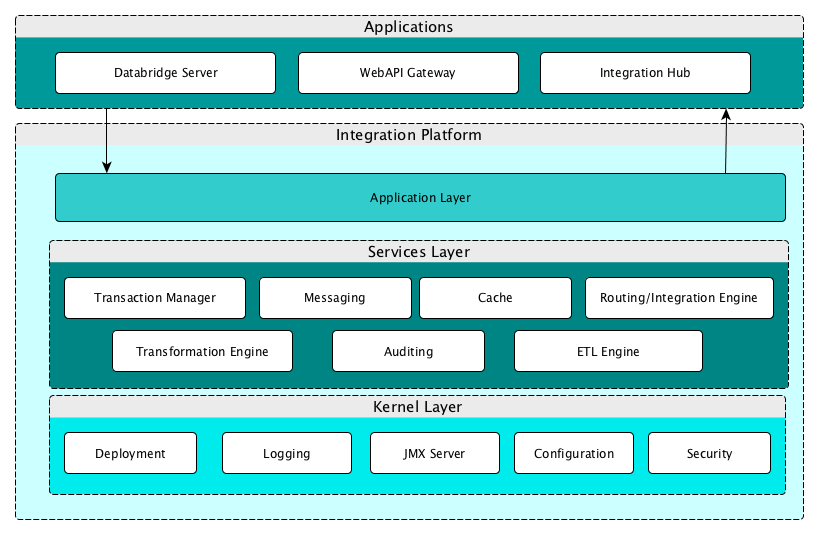Agora provides a platform to build different backend services.
- JDK 1.8
- Maven 3.3
- Spring Framework 4.2.3.RELEASE
- Spring Boot 1.3.0.RELEASE
- Spring Batch 3.0.5.RELEASE
- Apache Camel 2.16.1
- Spring Data 1.11.1.RELEASE
- Infinispan 8.1.2
- Apache Active MQ 5.6
- HikariCP 2.4.3
Nibodha Integration Platform(NIP) has a layered architecture that consists of
- Kernel Layer
- Services layer
- Application Layer
The agora kernel layer is based on Spring Boot that provides an embedded Jetty Servlet Container into which we can deploy the applications. The kernel layer provides the following features:
The agora provides support to deploy services external to the bundled application, so the customer/deployer can decide which service is being deployed on which server.
A dynamic logging component which is based on logback and supports different APIs like SLF4J, Java Logging etc.
The agora uses jolokia agent to provide restful access to the MBeans, so that the any mbean client can connect to the server.
The properties files for configuration are monitored and the changes are automatically propagated to the relevent services/applications
The security framework is based on spring security.
The agora services layer consists of embedded services which interact with the application layer to communicate with the applications built on top of the NIP. The services layer provides:
TODO: Tool choice for XA transaction manager (JBoss TS/Atomikos/Bitronix)
The messaging service is based on Apache Active MQ which allows the developer to create JMS Message Brokers and clients and deploy them.
The routing/integration engine based on Apache Camel allows the developer to define routes and implement enterprise integration patterns(EIP) and deploy the routes into the camel context.
The transformation engine is a custom bean mapping framework.
The auditing service logs the inbound and outbound messages to an audit log file.
The ETL engine is realized using Spring Batch, and is used extract transform and load from/to different datasources.
TODO: Add Info
TODO: Add Info
The integration platform is a multi module maven project with the following modules
- core - provides the implementation for the services and kernel layers in the architecture layers.
- launcher - provides services to launch the integration platform
- configuration - contains the platform configuration files
platform.mq.broker-url=tcp://localhost:61616
platform.mq.data-dir=${user.home}/mq-data
platform.mq.enabled=false
platform.mq.password=
platform.mq.user-name=
platform.jdbc.datasource.enabled=false
platform.jdbc.datasource.names=<comma separated ds names>
platform.jdbc.datasource.default.cache-prep-stmts=true
platform.jdbc.datasource.default.idle-timeout=30000
platform.jdbc.datasource.default.max-life-time=30000
platform.jdbc.datasource.default.maximum-pool-size=5
platform.jdbc.datasource.default.prep-stmt-cache-size=250
platform.jdbc.datasource.default.prep-stmt-cache-sql-limit=2048
platform.jdbc.datasource.default.use-server-prep-stmts=true
platform.jdbc.datasource.<dsname>.password=
platform.jdbc.datasource.<dsname>.jdbc-url=
platform.jdbc.datasource.<dsname>.user-name=
platform.cache.enabled=true
platform.cache.config=
The Nibodha's Integration Platform Agora is released under version 2.0 of the Apache License
a. Fork the integration-platform project to the developers gitlab account.
b. Clone the integration platform projects to developer's machine.
c. copy the settings.xml from configuration/etc folder to the maven local repository folder usually <user.home>/.m2
For windows C:\users\<username>\.m2
For linux/mac ~/.m2
Execute the following commands in terminal/command prompt
Build the integration-platform
mvn clean install
Change to launcher directory
cd launcher
Start the integration platform
mvn spring-boot:run
Change the property
platform.jdbc.datasource.enabled=true
Add datasource names
platform.jdbc.datasource.names=ds1
If more than one datasource needs to be added, add comma separated ds names.
Add jdbc url, user name, password properties for the datasource
platform.jdbc.datasource.ds1.jdbc-url=jdbc:oracle:thin:@localhost:1521:orcl
platform.jdbc.datasource.ds1.user-name=scott
platform.jdbc.datasource.ds1.password=tiger
The default values are taken for the other properities mentioned, if property need to be specified for a specific datasource replace "default" with datasource name.
